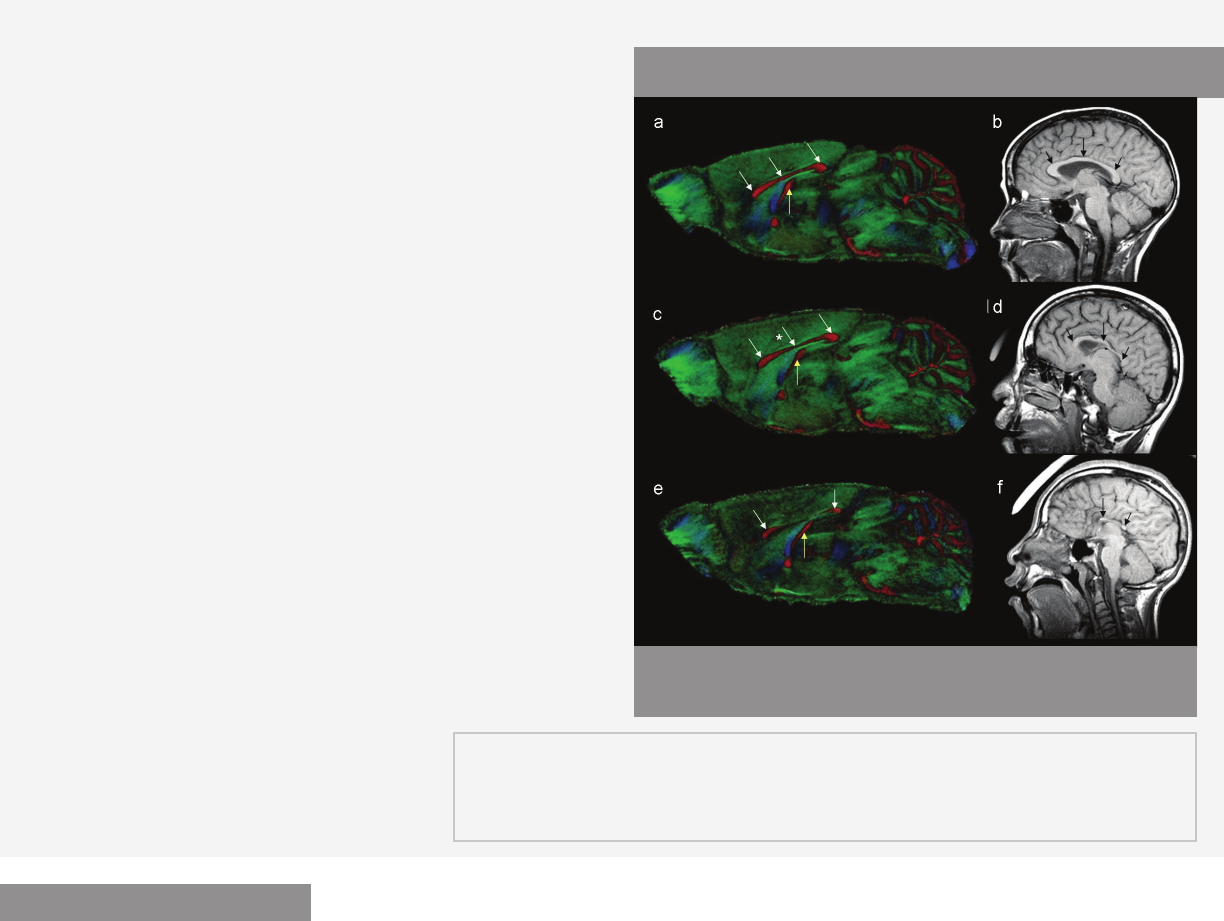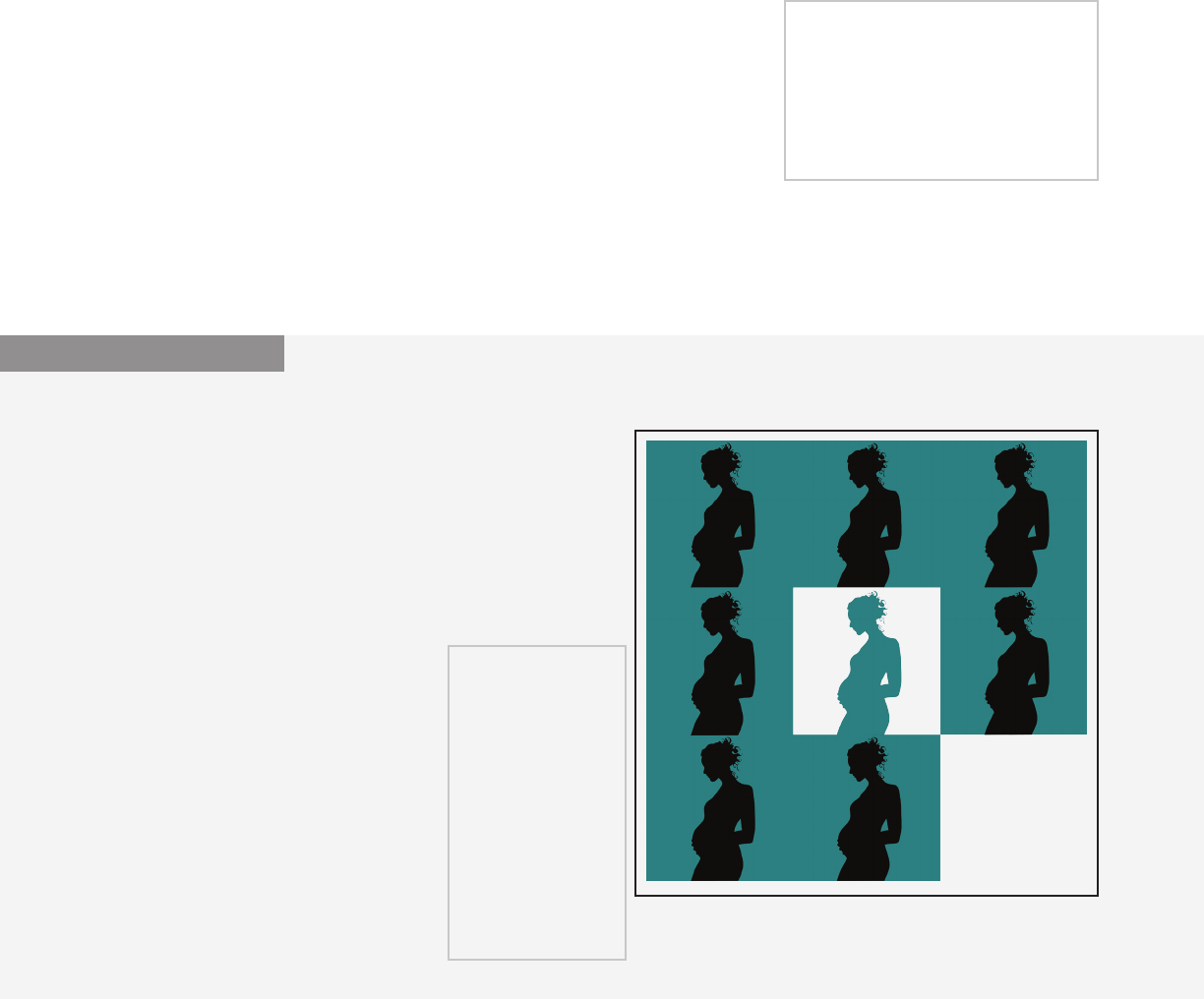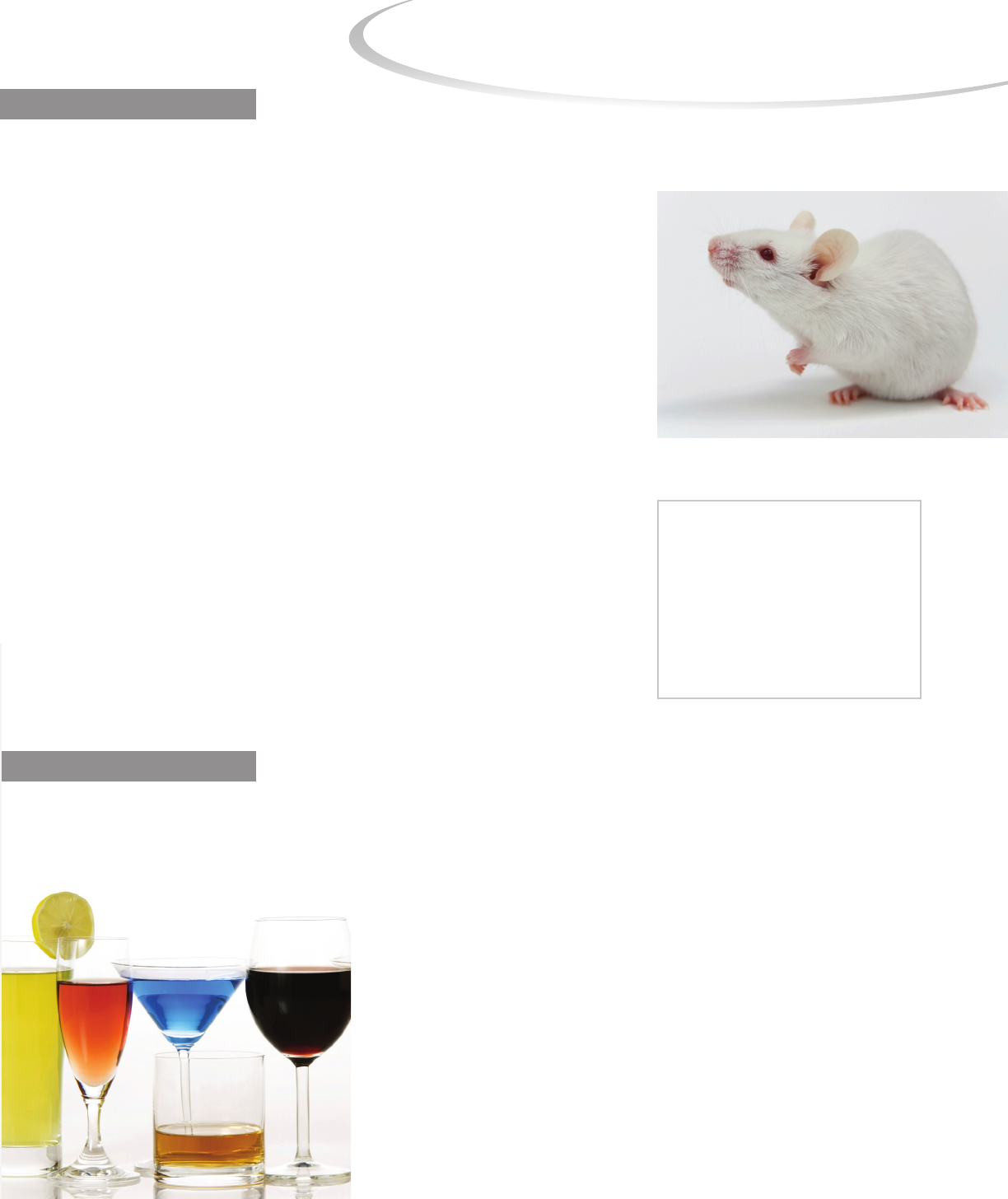
niaaa Spectrum
Volume 3, Issue 3 | September 2011 | http://www.spectrum.niaaa.nih.gov
U.S.DEPARTMENTOFHEALTHANDHUMANSERVICES•NationalInstitutesofHealth•NationalInstituteonAlcoholAbuseandAlcoholism
INTHISISSUE
FEATURES
1NIAAAAdvances
ResearchonFetalAlcohol
SpectrumDisorders
2ImagingHelps
ResearchersSeeInto
Alcohol-ExposedBrains
PHOTOESSAY
2BrainScansRevealthe
DamageofFetalAlcohol
Exposure
CHARTICLE
4OneinEightPregnant
WomenDrinks
NEWSFROMTHEFIELD
5ReceptorMayHelp
ExplainSusceptibilityto
Addiction
5
HeavilyAdvertisedAlcohol
BrandsMayAttractMore
UnderageDrinkers
6
ResearchShowstheValue
ofaMinimumLegal
DrinkingAgeof21
6EvidenceMountsThat
BingeDrinkingHarms
AdolescentBrain
Development
5QUESTIONSWITH...
7KennethWarren,Ph.D.
FEATURE
NIAAAADVANCESRESEARCHONFETAL
ALCOHOLSPECTRUMDISORDERS
In1967,whenFrenchpediatricianPaul
Lemoinerstrecognizedthatchildren
withalcoholicmothersshareda
patternofabnormalfacialfeaturesand
behaviorproblems,hedidnotgetmuch
attention.Backthen,conventional
wisdomheldtherewasnothingwrong
withdrinkingduringpregnancy.Most
doctorsneverevenraisedtheissue.
Buttodayweknowdifferently.
That’sinpartbecause,in1973,
pediatricianDavidSmithand
researcherKennethLyonsJones
uncoveredthesamerelationshipthat
Dr.Lemoinedid.Dr.Smithhopedto
bringmoreattentiontotheproblematic
patternbygivingitaname:fetal
alcoholsyndrome(FAS).
Thenameworked.Doctors,
researchers,andthepublicingeneral
begantopaymoreattentionto
FAS.Today,wehaveamuchbetter
understandingofthewiderangeof
braindamageanddevelopmental,
cognitive,andbehavioralproblems
causedbyfetalalcoholexposure.
Researchonthisrangeofproblems,
whichwenowcallfetalalcohol
spectrumdisorders(FASD),isatop
priorityforNIAAA.Withoursupport,
FASDresearchhasalreadycomea
longway.
“Initially,somepeoplethoughtthat
thisproblemonlyaffectedneglected
childrenofpooralcoholicwomen
whogrewupinunfavorablepostnatal
environments—andthat’swhythekids
didnotlookorbehavelikenormal
children.ButNIAAAfundedcritical
animalresearchstudiesthatshowed
thatalcoholisabletodisturbthe
growthanddevelopmentofanembryo
orfetus,”explainedSallyAnderson,
Ph.D.,NIAAA.
Today,NIAAAsupportsresearchers
aroundtheworldwhoaremaking
tremendousstrides.Inparticular,current
researchisadvancingmoreaccurate
diagnosesofFASD,distinguishing
FASDfromotherdisorders,and
determiningtheprevalenceofFASD
withgreaterprecision.
Accurate Diagnosis
SmithandJones’originaldescriptionof
FAShasnotchangedverymuch.People
withthefollowingthreefeaturesreceive
adiagnosisoffullFAS:
Continued on page 3
1 IN 8
PREGNANT
WOMEN
DRINKS

2
http://www.spectrum.niaaa.nih.gov
Volume3,Issue3|September2011
Continued on page 4
Continued from page 1
BRAINSCANSREVEALTHEDAMAGEOFFETALALCOHOLEXPOSURE
Theseimagesprovideacloserlook
athowprenatalalcoholexposurecan
damagethebrain.Magneticresonance
imaging(MRI)scansweretakenof
miceandhumanswithcomparable
amountsofalcoholexposureprior
tobirth.Thescansrevealdamageto
structuresthathelpthebrainfunction
properly(indicatedbywhiteand
blackarrows).Oneofthesestructures
isthecorpuscallosum,whichaids
communicationbetweenthebrain’s
twosides.
Fortheimagesontheleft,researchers
scannedthebrainsofmicethat
receiveddifferentlevelsofalcohol
duringgestation.OntherightareMRI
brainscansofchildrenknowntohave
prenatalalcoholexposurecomparable
tothoseofthemiceontheleft.
Therstmouse(a)wasnotexposed
toalcohol,anditscorpuscallosum
appearsnormal.Achildwithoutfetal
alcoholsyndrome(b)alsohasanormal
corpuscallosum.
Thesecondmouse(c)received
amoderatedoseofalcoholon
gestationalday7,whichcorresponds
tolateinweek3ofhumanprenatal
development.Thismousehasdamage
tothecorpuscallosum,particularly
evidentinathinner
middlesection.A
childwithmildFAS
(d)hascomparable
defectsinthecorpus
callosum.
Thethirdmouse(e)
receivedalarger
doseofalcoholon
gestationalday7,
anditshowsamore
severelyreduced
corpuscallosum.
Thismousealso
hasdamageto
thehippocampal
commissure(yellow
arrows),another
structureimportant
tocommunication
betweentheleftand
rightsidesofthe
brain.Inachildwith
severeFAS(f),the
corpuscallosumis
dramaticallyreduced
insize.
PHOTOESSAY
MRI scans that show comparable amounts of brain damage associated with
prenatal alcohol exposure. Mouse brains are shown on the left, and human
brains are on the right.
Sources:
O’Leary-MooreSK,ParnellSE,LipinskiRJ,SulikKK.Magneticresonance-basedimagingin
animalmodelsoffetalalcoholspectrumdisorder.Neuropsychology Review,2011Jun;21(2):167–85.
HumanMRIimagesarecourtesyofDr.S.Mattson.
FEATURE
IMAGINGHELPSRESEARCHERSSEEINTOALCOHOL-EXPOSEDBRAINS
Whenitcomestounderstandingthe
effectsofprenatalalcoholexposure
onthebrain,seeingisbelieving.
Advancesinimagingtechniquesare
allowingresearcherstogetafuller
pictureofhowalcoholcanaffectthe
developmentofthebrain’sstructure
and,consequently,itsfunctioning.
Theimagingtechniqueresearchersuse
mostoftenisMRI.Ingeneral,MRI
usesaverystrongmagnettocreate
animageofanypartofaperson’s
body.Butthereareveryspecictypes
ofMRItechnologythatarehelping
researchersshedlightondifferent
aspectsofabnormalitiescausedby
prenatalalcoholexposure,suchasthe
following:
Structural MRI (sMRI)usesastrong
magneticeldtodistinguishbetween
differenttypesofbraintissuesuch
asgraymatterandwhitematter.By
creatingacontrastbetweentissues,
sMRIallowsresearcherstomeasure
thevolumeofbrainstructuresand
thicknessofcorticaltissueand
comparemeasurementsbetween
differentgroupsofpeople.
Diffusion tensor imaging (DTI) uses
MRItechnologytocreateanimageof
braintissuebymeasuringthediffusion,
orthedirectionofmovement,ofwater
moleculesthroughbraintissues.In
particular,DTIishelpingresearchers
visualizeandunderstandthechanges
thataffectthestructureofwhitematter
bertractsduringbraindevelopment.
Magnetic resonance spectroscopy
(MRS)usesastrongmagneticeldto
measuretheconcentrationofchemicals
inthebrain.Thishelpsresearchers
understandthemetabolicchangesthat
takeplaceinthebrain.Researchers
useMRStocomparehealthybrainsto
brainsexposedtoalcoholprenatally.

niaaa Spectrum
3
IMAGINGHELPSRESEARCHERSSEEINTOALCOHOL-EXPOSEDBRAINS
NIAAA ADVANCES RESEARCH...Continued from page 1
•
Characteristicpatternoffacial
abnormalities;
•
Growthdecits,eitherprenatallyor
postnatally;and
• Centralnervoussystemdysfunction.
Butfetalalcoholexposuredoesnot
alwaysresultinallthreecharacteristics,
meaningthatsomepeoplewouldnot
receiveanFASdiagnosisalthoughthey
wereadverselyaffected.
“Initially,clinicianswereonlyable
toidentifyindividualswithFAS,”
explainedKennethWarren,Ph.D.,
actingdirectorofNIAAA,anda
leadingexpertonFASandFASD.
“Ifyoudidn’thavethedistinctive
facialfeatures,youweren’tdiagnosed
withFAS.Ifyoudidn’thaveagrowth
decit,youweren’tdiagnosedwith
FAS.Fortunately,ourabilityto
understandanddescribeotherareas
hasbeenenhancedandcontinuesto
improve,”Dr.Warrensaid.
Wenowincludeabroaderrangeof
effectsthatresultfromprenatalalcohol
exposureundertheumbrellatermof
FASD.InadditiontofullFAS,FASD
includes:
• Partial FAS,whichdescribespeople
withsomesignsandsymptomsof
fullFAS,butnotallthree.
• Alcohol-related birth defects,which
includeprenatalalcohol-induced
physicalabnormalitieswhich
affectvision,hearing,ortheheart,
kidneys,orskeletalstructure.
• Alcohol-related neurodevelopmental
disorder(ARND),whichdescribes
fetalalcohol-inducedimpairments
tothegrowthanddevelopmentof
thebrainorcentralnervoussystem,
and/orthecognitiveandbehavioral
problemsofFASwithoutfacialor
growthabnormalities.
Distinguishing FASD From Other
Disorders
TreatingFASDeffectivelydependson
anaccuratediagnosis.Unfortunately,
FASDarechronicallyunder-diagnosed.
Theproblemisthat“distinguishing
FASDfromotherdevelopmental
disordersistricky,andevolving
diagnosticstandardsarenotyet
acceptedbyeveryone,”explains
Dr.Anderson.
Often,peoplewithFASDare
mistakenlydiagnosedwithconditions
likeattentiondecithyperactivity
disorder(ADHD),whichalsocauses
learningandbehaviorproblems.
Currentresearchismakingthe
differencesbetweenFASDandother
disorderslikeADHDmuchclearer.
Forexample,wenowunderstand
thedifferenceinabehaviorcalled
perseveration.
“Perseverationisanimpairedability
toshiftfromonetasktoanother.Many
peoplewithADHDoftenswitchfrom
tasktotaskconstantly,butifyouask
someonewithintheFASDspectrum
toswitchfromoneactivitytoanother
veryquickly,theywilllikelybevery
resistant,”explainsDr.Warren.
Arecentreviewofresearchstudies
comparingchildrenwithFASDto
childrenwithADHDconcludedthat
childrenwithADHDhaveaharder
timefocusingandsustainingattention
whilechildrenwithFASDhavea
hardertimeshiftingattentionfromone
tasktoanotherandsolvingproblems
withexibility.Inaddition,children
withADHDhavetroubleretrieving
informationtheylearnverbally.By
contrast,childrenwithFASDhave
troubleencodingandremembering
verballylearnedinformation.Other
researchsuggeststhatstimulant
medication,whichoftenreduces
inattentionsymptomsinchildrenwith
ADHD,isnoteffectiveforchildren
withFASD.
Prevalence
WeknowthatFASDarethemost
common,preventabledevelopmental
disordersintheUnitedStates.Now,
NIAAAisfundinganewresearchstudy
thatwillimproveourknowledgeofjust
howmanypeopleareaffectedbyFASD.
NIAAAisdevelopinganetworkand
infrastructurecalledCollaborationon
FASDPrevalence(CoFASP)totest
kindergartenandrst-gradestudents
forsignsofFASD.Testingwillbegin
withstudentsinSanDiego,California;
GreatFalls,Montana;SiouxFalls,
NorthDakota;andseveralcommunities
inNorthCarolina.
“Thenewstudywillhelpdetermine
theprevalenceofFAS,partialFAS,
andARND,andalsohelpthechildren
inthosecommunitiesgetthespecial
educationservicestheyneedtothrive,”
saidDr.Warren.
Other Areas of Research
Clearly,researchhascomealong
waysinceDr.Lemoine’sdays.YetDr.
Warrenacknowledgesthereisstilla
lotwedonotyetfullyunderstand.The
breadthofresearchcontinuestogrow.
OtherareasofsignicantNIAAA-
fundedresearchonFASDinclude
demonstratingstructuralbraindamage
causedbyprenatalalcoholexposure
usingadvancedimaging,mitigatingthe
extentofalcohol-relatedbraindamage
throughnutrition,andunderstanding
theeffectofprenatalalcoholexposure
ongeneexpression.
“Ofcourse,ourhopeisthattherewill
beadaywhenpeoplenolongerhave
FASD.Butuntilthattime,wewill
continuetotrytounderstandthese
disordersasbestwecan.Themorewe
know,themorewecanimprovethelives
ofindividualswhostrugglewiththese
difcultieseveryday,”saidDr.Warren.
Sources:
Coles,CD.Discriminatingthe
effectsofprenatalalcoholexposure
fromotherbehavioralandlearning
disorders.Alcohol Research & Health,
Vol.34(1),p.47–48.
MattsonSN,CrockerN,NguyenTT.
Fetalalcoholspectrumdisorders:
neuropsychologicalandbehavioral
features.Neuropsychology Review,
2011,Vol.21,p.81.

4
Volume3,Issue3|September2011
http://www.spectrum.niaaa.nih.gov
IMAGING HELPS RESEARCHERS...Continued from page 2
Functional magnetic resonance
imaging (fMRI)usesastrongmagnetic
eldtoshowhowbloodowsinthe
brain.Generally,morebloodows
towardsanactivatedbrainstructure.
Researcherscantrackthisowof
bloodtodeterminewhatpartofthe
brainrespondstoparticularstimuli
andhowdifferentpartsofthebrain
function.fMRIalsoallowsresearchers
totrackmagneticallylabeledblood,
whichfollowsaspeciccoursewithin
thebrain.
MRIstudieshavehelpedscientists
matchupstructuralandfunctional
braindecits.Forexample,MRI
helpedEdwardRiley,Ph.D.,director
oftheCenterforBehavioralTeratology
andprofessorofpsychologyatSan
DiegoStateUniversity,realizethat
childrenwithFAShavesignicant
decitsinthecorpuscallosum.This
structurepromotescommunication
betweentheleftandrightsidesofthe
brain.
“UsingMRIstudies,wetrackeda
simpletask,”explainedDr.Riley.
“Weputkids’handsinaboxsothey
couldn’tseethem.Then,wetouched
theirngersandaskedthemtotellus
whichngerswetouched.”
Thechildrencouldverballyidentify
thetouchedngersonthehandthe
researchersactuallytouched.Butwhen
askedtopointtothengersthatwere
touchedontheoppositehand,“there
werealotmoremistakes,”saidDr.Riley.
Bytrackingthebrainactivityand
resultingfunctionwithMRI,Riley’s
studyshowed“that[kidswithFAS]have
difcultyintransferringinformation
fromonehemispheretoanother.”
Thisadvancedlevelofimaginghas
tremendouspotentialforhelping
researchersdevelopeffective
interventionandeducationstrategies.
Source:RoussotteF,SoderbergL,
SowellE.Structural,metabolic,and
functionalbrainabnormalitiesasa
resultofprenatalexposuretodrugsof
abuse:Evidencefromneuroimaging.
Neuropsychological Review,2010
Dec;20(4):376–97.Epub2010Oct28.
CHARTICLE
ONEINEIGHTPREGNANTWOMENDRINKS
Onaverage,about12percentof
pregnantwomendrinkandabout2
percentbingedrink(denedas5or
moredrinksononeoccasioninthepast
30days).Theserateshavechanged
verylittleovertime,accordingtoa
2009studybytheCentersforDisease
ControlandPreventionthatanalyzed
datafrom1991to2005.Perhaps
surprisingly,womenwhoareolderand
moreeducatedweremorelikelyto
drinkduringpregnancythanyounger,
lesseducatedwomen.About18
percentofpregnantwomenaged35–44
reporteddrinking,comparedwithabout
9percentofpregnantwomenaged
18–24.About14percentofpregnant
womenwithatleastonecollege
degreereporteddrinking,compared
withabout8percentofpregnant
womenwithahighschooldiploma
orless.Theresearchersspeculate
thatthepopulation
ofolderwomenmay
includemorewhoare
dependentonalcohol,
andthatwomenwith
moreeducationhave
morediscretionary
moneytospendon
alcohol.
Sources:
Centersfor
DiseaseControl
andPrevention.
Alcoholuse
amongpregnant
andnonpregnant
womenof
childbearingage:
UnitedStates,
1991–2005.
Morbidityand
Mortality Weekly
Report,2009May
22;58(19):529–32.
1 IN 8
PREGNANT
WOMEN
DRINKS

niaaa Spectrum
5
Continued on page 6
NEWSFROMTHEFIELD
RECEPTORMAYHELPEXPLAINSUSCEPTIBILITYTOADDICTION
Dopamine,abrainchemicalthat
playsimportantrolesinthecontrol
ofnormalmovementandinpleasure,
reward,andmotivation,alsoplaysa
centralroleinsubstanceabuseand
addiction.Inanewstudyconducted
inanimals,scientistsfoundthata
specicdopaminereceptor,called
D2,controlsanorganism’sactivity
levelandcontributestomotivation
forreward-seekingaswellastothe
rewardingeffectsofcocaine.Areport
ofthendings,byNIAAAresearchers,
appearsonlineinNature Neuroscience.
Inthestudy,scientistsinNIAAA’s
LaboratoryforIntegrative
NeuroscienceworkedwithArgentinean
researcherstodevelopgenetically
engineeredmiceinwhichexpressionof
D2receptorswasselectivelyprevented
innervecellsthatusedopamineas
theirneurotransmitter.Thereceptors
normallypresentonthesecellsare
knownasD2autoreceptors.
TheresearchersfoundthatlossofD2
autoreceptorsinthemiceprevented
thenormalfeedbackeffectbywhich
dopaminealreadypresentinbrain
synapsesreducessubsequentactivity
ofdopamine-containingneuronsand
dopaminerelease.Thiscontrolsystem
preventstheneurotransmitterfrom
reachingconcentrationsthatproduce
excessivelevelsofmovementand
otherbehaviors.Micethatlacked
D2autoreceptorsweremoreactive
thanmicewithnormalautoreceptor
levels.Wheninvestigatorsexamined
behaviorsrelatedtobrainmechanisms
ofrewardandaddiction,theyfound
thatmicelackingD2autoreceptors
workedlongerandhardertoobtain
foodandshowedincreasedsensitivity
totherewardingeffectsofcocaine,
comparedtonormalmice.Cocaine
increasedactivityinmice,andthe
micelackingD2autoreceptorswere
alsomoresensitivetothiseffectofthe
drug.Thestudymayhelpexplainwhy
alteredlevelsofD2receptorsinhuman
Thearticleabstractcanbefound
here:
Cocaine supersensitivity and
enhanced motivation for reward
in mice lacking dopamine D2
autoreceptors.
http://www.ncbi.nlm.nih.gov/
pubmed/21743470
midbrainandstriatumareassociated
withsusceptibilitytoaddiction.
NEWSFROMTHEFIELD
HEAVILYADVERTISEDALCOHOLBRANDSMAYATTRACTMORE
UNDERAGEDRINKERS
Underagealcoholuseisapervasive
andpersistentproblemintheUnited
Statesandmanyothercountries,with
serioushealthandsafetyconsequences.
Giventhesignicantamountofalcohol
advertisingtowhichyoungpeopleare
exposedinvirtuallyalltypesofmedia,
scientistshavesoughttolearnwhether
andhowsuchadvertisinginuences
underagedrinking.
InastudypublishedintheArchives of
Pediatrics and Adolescent Medicine,
NIAAA-supportedresearchers
asked2,699youthaged16–20about
theiralcoholuseandalcoholbrand
preferenceaspartofalong-term
telephonesurveyofU.S.adolescents
andmediause.Theresearchersreport
thatamajorityofunderagedrinkersin
thestudyidentiedapreferencefora
specicbrandofalcoholicbeverage,
thatthemost-preferredbrandsincluded
bothdistilledspiritsandbeer,and
thatbrandpreferencescorrelatedwith
levelsofbrand-specicadvertising
expenditures.Thiscorrelationsuggests
thatalcoholicbeveragemarketing
effortsmaybereachingandinuencing
underageaudiences.
Theresearchersalsofoundthatyoung
drinkerswhoidentiedapreferred
brandalsoweremorelikelytoengage

6
Volume3,Issue3|September2011
http://www.spectrum.niaaa.nih.gov
inbingedrinking.Thisnding
highlightstheneedforfurtherresearch
toidentifyanycausalconnections
betweenalcoholadvertising,brand
preferences,andbingedrinkingamong
underageyouths.
HEAVILY ADVERTISED ALCOHOL BRANDS . . . Continued from page 5
Source:
Alcohol brand preference and binge drinking among adolescents. Archives of
Pediatrics and Adolescent Medicine. 2011 Jul;165(7):675-6.
NEWSFROMTHEFIELD
RESEARCHSHOWSTHEECONOMICVALUEOFAMINIMUMLEGAL
DRINKINGAGE
Alcoholconsumptionanditsharms
arecommonamongyoungpeople,
includingthosewhoarebelow
theminimumlegaldrinkingage
(MLDA)of21.Researchersrecently
conductedeconomicanalysesto
estimatetheeffectsoftheMLDAon
deaths,injuries,crime,andalcohol
consumption,andtoidentifythecosts
andbenetsofloweringtheMLDA
to18.TheyreportintheJournal of
Economic Perspectivesthatalarge
bodyofevidenceshowsthatsettingthe
MLDAat21clearlyreducesalcohol
consumptionanditsmajorharms.
Theresearchersestimatethatlowering
theMLDAto18wouldresultinan
additional8deathsper100,000person
yearsforthe18–20agegroup.Using
acommonestimateofthevalueofa
statisticallifeof$8.72million,this
suggeststhatforevery100,000young
adultsallowedtodrinklegallyduring
ayear,theannualcostintermsof
increasedmortalitywouldbeabout$70
million.Theresearchersalsoestimate
thatloweringtheMLDAwouldimpose
additionalcostsonothersforcrime,
healthcare,anddeathsofnondrinking
driversandpassengersofatleast
$12millionannuallyforevery100,000
newlylegaldrinkers.Theseestimates
suggestthateachdrinkconsumedas
aresultofloweringtheMLDAwould
generateharmsvaluedatmorethan
$15tothedrinkerplusatleastan
additional$2.63inharmsimposedon
others,allinadditiontothepurchase
priceofthedrink.
Accordingtotheresearchers,“…the
evidencestronglysuggeststhatsetting
theminimumlegaldrinkingageat
21isbetterfromacostandbenet
perspectivethansettingitat18andthat
anyproposaltoreducethedrinking
ageshouldfaceaveryhighburdenof
proof.”
Thearticleabstractcanbefoundhere:
The minimum legal drinking age
and public health.
http://www.ncbi.nlm.nih.gov/
pubmed/21595328
NEWSFROMTHEFIELD
EVIDENCEMOUNTSTHATBINGEDRINKINGHARMSADOLESCENT
BRAINDEVELOPMENT
Adolescentswhodrinkalcoholoften
bingedrink.Whilethereisample
evidencethatadolescentbingedrinking
increasesriskybehaviorsandoften
resultsinnegativeconsequences,we
knowlessabouttheeffectsofalcohol
onadolescentbraindevelopment.
Nowresearchershaveshownthatthe
adolescentbrainexposedtobinge
drinkingrespondsdifferentlywhen
performingtestsofworkingmemory
andspatialfunctioningcomparedto
thoseofadolescentswhodonotbinge
drink.Previousresearchhaslinked
impairmentsinmemoryandspatial
functioningtoalcoholdependencein
adults.
Continued on page 7
5QUESTIONSWITH...

niaaa Spectrum
7
Inthecurrentstudy,theresearchers
examinedasampleof40adolescents
betweenages16and19whoreported
bingedrinkingatleastonceinthe
previous3months(bingedrinking
wasdenedasveormoredrinksfor
malesandfourormoreforfemaleson
atleastoneoccasion).UsingfMRI,the
researchersexaminedbloodowto
severalbrainregionsasameasureof
brainactivationwhiletheadolescents
performedspatialworkingmemory
tests.ThefMRIshowedthatadolescents
whoreportedbingedrinkingexhibited
differentlevelsofregionalbrain
activationcomparedtocontrolsubjects,
suggestingalcohol-relateddifferences
inbrainfunction.
Whencomparedtothesamegender
controls,femaleadolescentbinge
drinkersexhibitedreducedregional
brainactivation,whilemaleadolescent
bingedrinkersexhibitedequalor
elevatedregionalactivation.The
reducedactivationobservedin
femaleswascorrelatedwithpoorer
performanceinsustainedattentionand
workingmemory,whiletheincreased
activationinmaleswascorrelated
withimprovedperformanceinspatial
functioning.Thesedatasuggestthere
maybeimportantgenderdifferencesin
theimpactofalcoholontheadolescent
brain.
Overall,thendingssuggestthat
theregionsoftheadolescentbrain
responsibleforworkingmemoryand
spatialfunctioningmaybevulnerable
tothephysiologicaleffectsofbinge
drinking,withfemalespotentially
beingmoreatriskthanmales.These
effectscouldhaveimplicationsfor
futurebehaviorsextendinginto
adulthood.
Thearticleabstractcanbefound
here:
Adolescent binge drinking linked
to abnormal spatial working
memory brain activation:
Differential gender effects.
http://www.ncbi.nlm.nih.gov/
pubmed/21762178
5QUESTIONSWITH...
KENNETHWARREN,PH.D.
Dr. Warren is the acting director of NIAAA.
1.
WhyisFASDsuch
animportant
researchareaforNIAAA?
Prenatalalcoholexposure
istheleadingpreventable
causeofbirthdefects
anddevelopmental
disordersintheUnitedStates.The
disabilitiesassociatedwithFASD
canpersistthroughoutlifeandplace
heavyemotionalandnancialburdens
onindividuals,families,andsociety.
Sofromapublichealthperspective,
thisisaseriousandentrenched
problem.Meanwhile,fromaresearch
opportunitiesperspective,studies
continuetoprovidenewinsightsinto
thenatureofthediseaseandpotential
interventionandtreatmentstrategies.
Giventhepublichealthneedandthe
potentialofourresearch,FASDisan
obviouspriorityareaforus.
2.
Whatimportantresearch
advanceshaveoccurredsince
therstformaldescriptionofFASwas
introducedin1973?
Ithinkwehavemadesignicant
progressinthreedistinctareas.
First,wehavedevelopedamuch
morecomprehensiveandnuanced
understandingoftheeffectsofprenatal
alcoholconsumption,andhave
renedourterminologytoreectthis
evolution.Whileweoncehadonly
arelativelysimpleunderstandingof
FAS,wenowrecognizethatdrinking
duringpregnancycanleadtoFASD,
afullspectrumofneurobehavioral
effectsthatrangefromintellectual
andlearningdisabilities,poor
executivefunction,andspeechand
languagedelaystobehavioraland
emotionaldifculties,poorsocial
skills,andmotordecits.Thisnuanced
understandinghelpsresearcherspaint
anaccurateandrealisticpictureofthe
subtlecomplexitiesofthesedisorders
astheysearchforbetterintervention
strategies.
Second,researchershavemade
progressinunderstandinghowalcohol
damagesthefetus(includingepigenetic
inuences)andinthepotentialof
preventingsuchdamagethrough
pharmacotherapeuticinterventions
duringpregnancy.Andnally,
researchersareexploringnewways
touseeducational,behavioral,and
nutritionalinterventionstoimproveor
EVIDENCE MOUNTS THAT . . . Continued from page 6
Continued on page 8

8
Volume3,Issue3|September2011
fullyrestorebehavioralandcognitive
functionsinFASDpatients.
Takentogether,theseresearch
developmentsholdgreatpromisefor
effectiveinterventionsthatcanhelp
reducetheheavyburdensofFASDfor
patientsandtheirfamilies.
3.
Whataresomeoftheongoing
challengesweface?
Despitethegrowingbodyofresearch
evidence,toomanypregnantwomen
continuetodrink,andmanypeoplestill
questionwhetheralcoholconsumption
duringpregnancyisariskybehaviorat
all.Sondingeffectiveandculturally
relevantpreventionandintervention
strategiesremainsanelusivegoal.
Wealsoneedtocontinuetoimprove
ourknowledgeinareaswherewe
havebeenmakingprogress,suchas
developingtoolstobetteridentifyall
affectedindividualsandtheirunique
patternsofalcohol-induceddecits.
Newtechnologiesareprovingtobe
extremelypromising,suchasthenew
three-dimensionalimagingtoolsfor
detectingsubtlefacialcharacteristics
associatedwithprenatalalcohol
exposure.Yetweneedtomaintainour
researchfocusandbuilduponthese
advances.Thatway,wecandevelop
arangeoftoolstoidentifyalcohol-
relatedconditionsquicklyandprovide
appropriatemedicalandsocialservices
promptly.
Wemustalsounderstandmore
fullyhowthequantity,frequency,
andtimingofalcoholexposureand
maternalfactorssuchasthemother’s
age,numberofpriorpregnancies,
nutrition,andmetabolisminuencethe
developmentofFASD.Understanding
themechanismsunderlyingalcohol’s
detrimentaleffects,aswellasthe
geneticandsocioeconomicfactors
contributingtotheriskforFASD,
willallowresearchersandclinicians
toidentifyalcohol-relatedconditions
moreefcientlyanddevelopmore
targetedandeffectivepreventionand
treatmentstrategies.
4.
AsourunderstandingofFASD
difculttokeepstakeholdersandthe
continuestoevolve,hasitbeen
publicapprisedofalltheresearch
developments?
Perceptionscanbedifculttochange.
Butwearefortunatethatanumber
ofadvocacyorganizations,bothin
theUnitedStatesandabroad,are
dedicatedtohelpingusbringresearch
informationtoFASDstakeholders
andthepublic.Theseorganizations
havebeenvitaltotheprogressof
FASDresearchandeducation.For
example,intheUnitedStates,the
NationalOrganizationonFetalAlcohol
Syndrome(NOFAS)andtheFAS
CommunityResourceCenterhave
doneagreatjobofincreasingpublic
awareness,mobilizinggrassroots
action,andservingasliaisons
amongthemanyFASDstakeholder
communities.Theseorganizationsalso
educatepatients,healthcareproviders,
andpolicymakers.Andmostofall,
groupsliketheseprovideimportant
feedbackfromthefamiliesofaffected
individuals,helpingtoimproveour
clinicalandpreventioneffortsandthe
communityprogramsweserve.
5.
After35years,youhave
certainlymadeyourmarkinthe
alcoholeld.Lookingback,whatother
careerscapturedyourimagination?
AsayoungmanintheBronx,I
workedasamusician.Thinking
back,continuingtoplaymusicin
clubswouldhavealsomadeforan
interestingprofessionallife.
ABOUT US
NIAAA SpectrumisNIAAA’srst-ever
webzine.Withengagingfeaturearticles,
shortnewsupdates,andcolorful
graphics,NIAAA Spectrumoffers
accessibleandrelevantinformationon
NIAAAandthealcoholresearcheld
forawiderangeofaudiences.Each
issueincludesfeature-lengthstories,
newsupdatesfromtheeld,charticles
andphotoessays,andaninterviewwith
anNIAAAstaffmemberoralcohol
researcher.NIAAA Spectrum is
publishedthreetimesayear.
CONTACT US
National Institute on Alcohol
Abuse and Alcoholism (NIAAA)
5635FishersLane,MSC9304
Bethesda,MD20892-9304
Communications/PublicInfo:
301–443–3860
http://www.spectrum.niaaa.nih.gov
LearnmoreaboutcurrentFASDresearch
inthemostrecentissueofAlcohol
Research & Health,theNIAAAjournal.
Adownloadablecopyisavailableathttp://
pubs.niaaa.nih.gov/publications/arh341/
toc34_1.htm.
